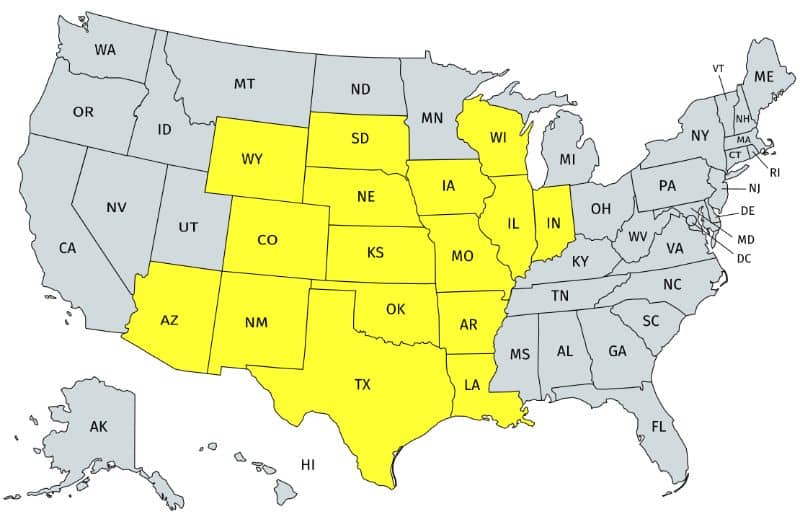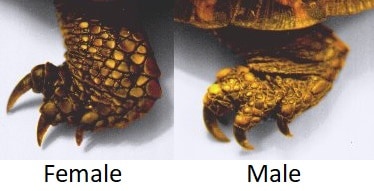The Ornate box turtle is a North American box turtle of the genus Terrapene that can generally be recognized by its characteristic yellow lines on their dark brown carapace (the upper part of the shell). Its plastron, the lower part of the shell, is also ornamented by yellow and dark brown lines. The Ornate box turtle is native to the states in and around the Great Plains of the United States. Like all other types of box turtles, it is a land based turtle and lives in prairie areas.

This post provides an overview of the most important Ornate box turtle care tips, their size, lifespan, interesting facts and much more.
Here you can find a quick overview of the main contents of this page:
– Ornate box turtle care tips
– Ornate box turtle habitat and range
– Size
– Lifespan
– How to tell the gender
– Ornate box turtle facts
– Scientific classification
Ornate box turtle care tips
Ornate box turtles are beautiful creatures. But they are one of the most difficult box turtle species to keep as pets. If you are a new aspiring box turtle owner, it would be best to start off with an Eastern or Three-toed box turtle which make better pet turtles. If you have the time, space and devotion, keeping an Ornate box turtle pet can be very rewarding, however. They are lively and inquisitive little creatures. The next section provides an overview of Ornate box turtle care tips.
Ornate box turtle diet / what do Ornate box turtles eat
As all other species of box turtles, Ornate box turtles are omnivores. In the wild, they feed on anything they can find in their natural habitat. Their diet ranges from various worms, beetles and other insects to vegetables, grasses, fruits, mushrooms and roots.
If kept as pets, the diet of your Ornate box turtle should consist of the following:
- 50% proteins – live earthworms, super worms, waxworms, slugs, beetles, grubs, boiled chicken, low-fat premium box turtle food, puppy milkbones
- 30% vegetables – squash, peas, sweet potatoes
- 10% leafy greens – collard greens, mustard greens, wheat grass
- 10% fruits – banana, kiwi, grape, apple and other fruits

Click here to read more about the ideal box turtle diet and required vitamins and minerals.
Ornate box turtle habitat and range
The natural habitat of Ornate box turtles is in the arid prairie grasslands of the Great Plains of the United States and in Northern Mexico.

They like to roam around the large open areas and need soft soil to burrow into during the hot hours of the day and for hibernation during the winter months.
All box turtle species are ectothermic. That means that they cannot regulate their own body temperatures like humans do. If the outside temperatures are too high, box turtles slow down and try to find a space to hid from the heat. Since the natural habitat of Western Ornate box turtles are often in hot areas, they dig into the soil during the hottest time of the day to keep their body temperature lower.
An Ornate box turtle pet is best kept outdoors in areas where they naturally occur with the right climate. Compared to species of the common box turtle like the Eastern box turtle or the Three-toed box turtle, they are harder to keep indoors.
Regardless of where you keep your Ornate box turtle, your habitat should contain the following elements in addition to the standard elements of a box turtle habitat:
- Due to their strong instinct for digging, an enclosure that keeps an Ornate box turtle needs to have a digging spot. If you keep an Ornate box turtle in an indoor enclosure, you can provide a mount of sphagnum moss on the cooler side of the pen that is kept moist at all times. For an outdoor enclosure, provide an area with loose topsoil at least 15 inches (40cm) deep.
- Ornate box turtles like to climb. Make sure to surround your enclosure with high fences
- Ornate box turtles need higher temperatures and lower humidity levels than other box turtles. Detailed information can be found in the next section.

Ideal temperatures and humidity levels
Ornate box turtles should always be kept at optimal temperature and humidity levels. Otherwise, they are prone to eye infections, other diseases or will stop eating and get weak. Below you can find the ideal temperatures and humidity levels:
- Daytime Temperature: 70-90°F (21-32°C)
- Basking spot (warm side of the pen) 85-88°F (29-32°C)
- Nighttime Temperature: 65-75°F (18-24°C)
- Humidity: Around 40%, higher for hatchlings
If you do not live in an area where these temperatures occur outdoors, you should keep a difference species of box turtle or keep the Ornate box turtle indoors. During the cooler winter months, they will dig into the soil and hibernate for up to 6 months.
Read our guide on how to create the perfect environment with lights, temperature and humidity for your box turtle here.
Size
Ornate box turtles are the smallest species of the North American box turtles. Adults usually reach a size of 4-5 inches (10-13 cm). The largest ever recorded specimen reached a size of 5.9 inches (15 cm).
Ornate box turtle hatchlings are barely the size of a quarter. In the first two years, their shells are still soft and they are unable to retract their body into the shell. After around two years, the shell develops a hinge on the lower part, called the plastron, which enables the turtle to retract inside the shell and close the opening.
After 8-10 years, Ornate box turtles are fully-grown and reach sexual maturity.
Lifespan
After the female lays its eggs, it leaves the site and never returns to its hatchlings. This means that from the day of their birth onwards, box turtle hatchlings in the wild are fighting for survival by themselves. Since their shell is still soft and vulnerable in the first two years of their life, they are easy prey to raptor birds, crows, opossums snakes, dogs and many other predators. It has even been recorded that adult box turtles have fed on helpless box turtle hatchlings. Therefore, most Ornate box turtle hatchlings never make it past the first two hard years of their life.
After surviving infancy, the average life expectancy of an Ornate box turtle is around 35 years. Compared to other box turtle species, the life expectancy of the slightly smaller Ornate box turtle is shorter. However, some specimen have been recorded to reach high ages of up to 70 years.
How to tell the gender of an Ornate box turtle
As for all box turtle species, it is not possible to tell the gender of an Ornate box turtle by looking at its genitalia. These are hidden inside the shell and usually not visible from the outside. However, several secondary gender elements can be used to tell the difference between a male and a female specimen. Overall, sexing an Ornate box tortoise is somewhat more difficult than Eastern or Three-toed box turtles but still possible.
While male Ornate box turtles are usually smaller than females, the size alone is not an ideal criteria to determine the gender since it depends on several other factors like age, diet and overall health.
The best way to tell the difference between a male and a female Ornate box turtle is by taking a close look at its back claws. For males, the inner claw is usually large and curved while the female’s is shorter and straighter.
For Ornate box turtles, the temperature at which the eggs are incubated determines the sex. Eggs that are incubated at 84°F (29°C) produce all-female hatchlings. Since these temperatures often occur in the natural habitat of Ornate box turtles, females occur about twice as often as males.
Read our more detailed guide on how to tell the sex of your box turtle.

Also, males usually have a longer and thicker tail than females and their cloacal opening is farther back on their tail. There is also a minor difference in the color of the head and legs for the different genders. Males often have a reddish coloring to their limbs.
Ornate box turtle facts
- The Ornate box turtle is the state reptile of Kansas
- The meat of Ornate box turtles can be poisonous and inedible for humans. Generally, Ornate box turtles are not poisonous. However, they sometimes eat poisonous mushrooms and the poison is absorbed into the meat of the turtle while the toxins do not have any effect for box turtles. Even though you should never even consider eating the meat of a box turtle due to conservation concerns, this is another warning not to do so.
- The number of Ornate box turtles in the wild has greatly decreased over the last decades. Due to the growing agriculture areas in the Great Plains region, the natural habitat is becoming smaller. Many wild Ornate box turtles have also been removed from their surroundings and sold as pets. Never remove a box turtle from the wild. If you want to buy a box turtle as a pet, read our guide on what to know beforehand first.
- Ornate box turtles are listed as endangered in Illinois and Indiana and as nearly threatened worldwide.
Scientific classification
- Kingdom: Animalia
- Phylum: Chordata
- Class: Reptilia
- Order: Testudines
- Suborder: Cryptodira
- Superfamily: Testudinoidea
- Family: Emydidae
- Genus: Terrapene
- Species: Terrapene ornata
- Subspecies: Terrapene ornata ornata
The Ornate box turtle is a subspecies of the Western box turtle. The only other subspecies of the Terrapene ornata is the Desert box turtle. They both have similar patterns on their shell but the Desert box turtle is a bit larger.

5 thoughts on “Ornate Box Turtle – Facts and Care Tips”
Comments are closed.